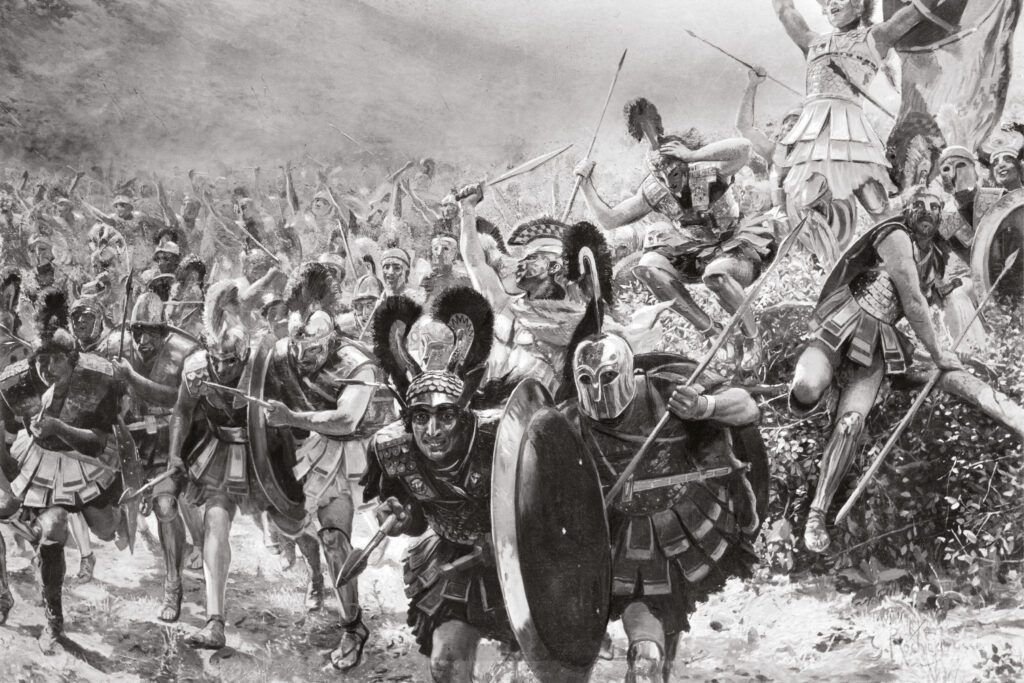The Battle of Marathon, fought in 490 BCE, showcased the brilliance of Greek military strategy. The battle between the Athenians and the Persian Empire demonstrated the effectiveness of Greek tactics, highlighting preparation, discipline, and unity in warfare. The Persian Empire, led by King Darius I, sought to punish Athens for supporting a rebellion in Ionia. The Athenians prepared for battle with limited support from other Greek city-states. The Greek hoplite infantry played a crucial role in the victory, forming a phalanx and nullifying the impact of Persian archers. Despite the Persian cavalry advantage, Athenian general Miltiades devised a pincer movement that trapped and defeated the Persians. The victory at Marathon halted the Persian invasion and united the Greek city-states, setting the stage for future victories. The battle stands as a testament to the brilliance of Greek military strategy and the power of a well-trained and prepared army.
The Battle of Marathon: Triumph of Greek Military Strategy
Introduction
The Battle of Marathon, fought in 490 BCE, was a pivotal event in ancient Greek history that showcased the ingenuity and strategic brilliance of the Greek military. This battle, fought between the Athenians and the Persian Empire, demonstrated the effectiveness of Greek military tactics and highlighted the importance of preparation, discipline, and unity in warfare.
The Persian Invasion
The Persian Empire, under the command of King Darius I, had successfully conquered many territories in the eastern Mediterranean and sought to expand its influence further westward. In 490 BCE, Darius launched an invasion fleet to punish Athens for their support of Ionia, a region on the western coast of modern-day Turkey that had rebelled against Persian rule.
The Athenian Defenders
Aware of the impending Persian invasion, the Athenians prepared for battle by seeking assistance from their fellow Greek city-states. However, due to various reasons, only the Plataeans, a small city-state located near Athens, offered their support. As a result, the Athenians were left to face the Persian forces mainly on their own.
Strategic Brilliance – Greek Hoplite Infantry
The Greek hoplite infantry played a crucial role in the victory at Marathon. Hoplites, heavily armed soldiers, were the backbone of the Greek army and were renowned for their discipline and cohesion. In the Battle of Marathon, the Athenian hoplites formed a phalanx, a tight formation that presented an impenetrable wall of spears and shields to the Persian forces. This formation granted them remarkable defensive capabilities and nullified the Persian archers’ impact.
Persian Cavalry Advantage
Although the hoplite infantry proved highly effective, the Persian forces had their trump card – cavalry. The Persian cavalrymen were skilled horsemen and posed a significant threat to the Greek phalanx. Aware of this disadvantage, the Athenian general Miltiades formulated a tactical plan to neutralize the Persian cavalry advantage.
The Pincer Movement
Miltiades devised a bold strategy where the Greek phalanx would thin out its center and reinforce its wings. This maneuver created a gap in the Greek defensive line, inviting the Persian cavalry to charge through and flank the Greek soldiers. However, Miltiades had anticipated this move and ordered his wings to pivot inward, enveloping the Persian cavalry between the Greek phalanx and the rocky terrain behind them.
The Greek Victory
The Battle of Marathon unfolded in favor of the Greeks. The tightly packed Persian cavalry, trapped between the Greeks and the natural barriers, found themselves in disarray. Meanwhile, the Greek hoplites, armed with longer spears and shields, easily dispatched the Persian foot soldiers. The cohesive discipline of the hoplites proved superior to the Persian’s less organized troops.
Legacy and Significance
The victory at Marathon had immense significance for the Greeks. It not only halted the Persian invasion but also instilled a sense of confidence and unity among the Greek city-states. This battle became a turning point in the Greco-Persian Wars and set the stage for future Greek victories at sea battles like Artemisium and Plataea.
Conclusion
The Battle of Marathon stands as a testament to the brilliance of Greek military strategy. Despite being heavily outnumbered, the Athenians leveraged their disciplined hoplite infantry and strategic thinking to secure a decisive victory against the Persian Empire. The battle showcased the effectiveness of a well-trained and well-prepared army, proving that even in the face of daunting odds, Greek military strategy could triumph.
